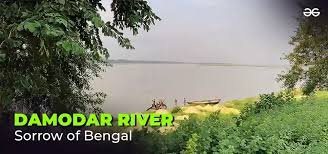The Damodar River: Sorrow of West Bengal
Introduction to Damodar River
The Damodar River, originating from the Chota Nagpur Plateau, flows through Jharkhand and West Bengal. It is notable for its mineral-rich waters that contribute significantly to India’s mining industry. However, it has also earned the moniker “Sorrow of West Bengal” due to its history of destructive floods.
Impact of Damodar River Floods
The Damodar River is infamous for its devastating floods, particularly in the Bardhaman, Hooghly, Howrah, and Medinipur districts of West Bengal. These floods have historically led to massive loss of life, property, and agricultural land. The frequent flooding has necessitated significant disaster management efforts and infrastructural developments, such as the construction of dams and canals to control the water flow.
Importance of the Damodar River
Despite its destructive capacity, the Damodar River plays a crucial role in irrigation and industrial activities in the region. Its waters are harnessed for agriculture, providing much-needed irrigation to vast tracts of farmland. Additionally, the river supports industrial processes, particularly in the steel and mining sectors, which are vital to the regional and national economy.
Efforts to Mitigate Floods
To mitigate the flooding, a series of dams have been constructed along the river, including the Maithon, Panchet, and Tilaiya dams. These dams are part of the Damodar Valley Corporation (DVC) initiative, which aims to manage water resources, generate hydroelectric power, and control floods. These efforts have significantly reduced the frequency and severity of flooding, although the river still poses a risk during heavy monsoon seasons.
Ecological and Environmental Considerations
The environmental impact of damming the Damodar River has been a topic of discussion. While the dams have provided substantial flood control and irrigation benefits, they have also altered the natural flow of the river, affecting local ecosystems. Efforts are ongoing to balance the ecological health of the river with the needs of human populations dependent on its resources.

Why This News is Important
Significance for Government Exam Aspirants
Understanding the dynamics of the Damodar River is crucial for students preparing for government exams. Knowledge of India’s geography, natural resources, and disaster management strategies is often tested, making this information relevant.
Historical and Environmental Studies
The historical impact of the Damodar River floods offers insight into India’s environmental challenges and responses. Exam aspirants in fields like civil services, banking, and railways can benefit from comprehending these aspects for better analytical and decision-making skills.
Policy and Infrastructure Development
The government’s efforts in managing the Damodar River through infrastructure projects like the DVC provide a case study in public policy and infrastructure development. This knowledge is particularly pertinent for positions in public administration and urban planning.
Regional Economic Contributions
The role of the Damodar River in supporting regional economies through irrigation and industrial activities highlights the interplay between natural resources and economic development. This is essential knowledge for exams focused on economics and development studies.
Disaster Management and Mitigation
Understanding the flood management strategies implemented for the Damodar River enhances knowledge in disaster management, a critical component in exams for defence services and administrative positions.
Historical Context
The Legacy of the Damodar River Floods
The Damodar River has been notorious for its floods since ancient times, earning the title “Sorrow of Bengal.” Historically, these floods have caused widespread devastation, prompting the need for effective management strategies. The establishment of the Damodar Valley Corporation in 1948 marked a significant step towards mitigating the adverse effects of these floods through the construction of dams and reservoirs.
Development of the Damodar Valley Corporation (DVC)
The DVC, modeled after the Tennessee Valley Authority (TVA) in the United States, was India’s first multipurpose river valley project. It aimed to harness the Damodar River for flood control, irrigation, and hydroelectric power generation. The construction of major dams under this project has been pivotal in transforming the river from a source of sorrow to a valuable resource for economic development.
Key Takeaways from the “Sorrow of West Bengal” News
| S.No. | Key Takeaway |
|---|---|
| 1 | The Damodar River, known as the “Sorrow of West Bengal,” is infamous for its devastating floods. |
| 2 | The river flows through Jharkhand and West Bengal, contributing significantly to India’s mining sector. |
| 3 | Major floods in districts like Bardhaman, Hooghly, Howrah, and Medinipur have caused extensive damage historically. |
| 4 | The Damodar Valley Corporation (DVC) was established to manage the river’s water resources and mitigate flooding. |
| 5 | The construction of dams under the DVC has significantly reduced the frequency and severity of floods while supporting irrigation and industrial activities. |
Important FAQs for Students from this News
1. Why is the Damodar River called the “Sorrow of West Bengal”?
The Damodar River is called the “Sorrow of West Bengal” due to its history of frequent and devastating floods that have caused extensive damage to life, property, and agriculture in the region.
2. What steps have been taken to control the flooding of the Damodar River?
The establishment of the Damodar Valley Corporation (DVC) and the construction of several dams, such as Maithon, Panchet, and Tilaiya, have been major steps taken to control the flooding and manage the water resources of the Damodar River.
3. What are the major benefits of the Damodar River despite its destructive floods?
The Damodar River supports irrigation, which is vital for agriculture, and provides water for industrial activities, particularly in the mining and steel sectors, contributing significantly to the regional economy.
4. How has the Damodar Valley Corporation (DVC) impacted the region?
The DVC has significantly reduced the frequency and severity of floods, provided hydroelectric power, and improved irrigation facilities, thereby aiding in regional development and economic growth.
5. What ecological impacts have the dams on the Damodar River caused?
The construction of dams has altered the natural flow of the river, impacting local ecosystems. Efforts are ongoing to balance the ecological health of the river with the needs of human populations.
Some Important Current Affairs Links


















